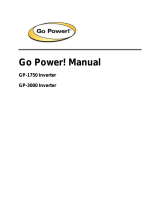
If a piece of equipment or an appliance will not operate, first
confirm that the inverter has been properly connected to the 12
volt power source. If all connections have been properly made,
turn the inverter rocker switch ON (l), OFF (O) and ON (I) again
in quick succession. If this procedure is unsuccessful, it is likely
that the inverter does not have the required start up capacity to
operate the equipment or appliance in question.
Selecting the Optimum Power Source.
Operating the inverter for extended periods combined with
a high continuous load demand may result in excessive
power drain from the battery. Therefore, the reserve capacity
of the battery you select to power the inverter is an
important consideration.
The potential power drain can be estimated by calculating
the reserve power (“amp-hour”or Ah) of the battery and the
amps required by the inverter to meet the continuous load
demand of the equipment or appliance being operated.
1. To calculate the Ah of the battery, first determine its “reserve
minutes” rating. (Deep cycle marine batteries generally have the
highest reserve minute ratings). This rating typically is marked
on the battery along with the “Cold Cranking Amps” (CCA)
rating. Multiply the reserve minutes rating of the battery by 0.3
to determine the battery approximate Ah rating. A battery with
a reserve minutes rating of 166 has an Ah rating of 49.8.
2. To estimate the maximum battery current the inverter will
require to run a piece of equipment or appliance, divide its
continuous load wattage requirement by 10.
The 1200W watt model utilizes 50 amps of battery power
to operate an appliance with a 500 watt continuous load
requirement. (500W divided by 10V = 50A).
BATTERY INFORMATION
9






















